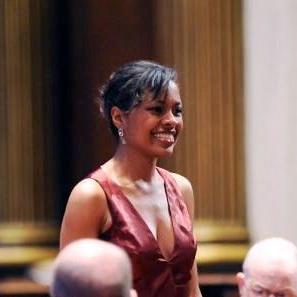Brazilian soprano, French ensemble close Baroque Festival in style

Luanda Siqueira da Silva performed music of the French Baroque Saturday night in Coral Gables.
The twelfth annual Tropical Baroque Music Festival concluded Saturday night with Aix-en-Musique, a tribute to Coral Gables’ sister city Aix-en-Provence, at the new Coral Gables Museum. Despite an adjacent street fair and parking problems, a nearly full house was on hand for a program of French Baroque vocal music featuring the gifted Brazilian soprano Luanda Siqueira da Silva and the Paris-based instrumental ensemble Fuoco E Cenere.
The acoustics in the high-ceilinged gallery room that was utilized proved far from ingratiating. Over-reverberant with a slight echo, the space tended to short change instrumental subtleties and bleach out vocal projection. Despite less-than-ideal sound, the fine musicianship, compelling repertoire and intimacy of the performance propelled a delightful musical travelogue.
Siqueira brings wide experience in Baroque opera with numerous early music ensembles and French opera houses. Her rich, dark lower register and pinpoint coloratura were a joy to hear. In extended cantatas by Andre Campra (1660-1744) and Louis-Nicolas Clerambault (1676-1749), Siqueira’s superb dramatic projection, vocal purity and dynamic intensity enthralled the unusually quiet and attentive audience.
The Didon cantata by Campra, one of Aix’s favorite sons, covers the same subject matter utilized by Purcell in Dido and Aeneas and Berlioz in Les Troyens. Unlike the austerity of Purcell’s setting or the impassioned romanticism of Berlioz’s operatic version, Campra paints Dido’s despair at losing her lover and death in elegant French Baroque colors, alternating agitated recitatives with luminous melodic arias that tax the extremes of the soprano’s vocal range. The sincerity and emotional power of Siqueira’s performance turned the score into a mini-opera, a roller coaster of love, hate and death.
While Clerambault’s Orphee lacks Campra’s vocal and instrumental invention, this retelling of the Orpheus legend with a happy ending is replete with gracious melodies and beguiling emotive roulades that provided a showcase for Siqueira’s wide vocal range. That she can achieve such dramatic focus through the purest vocal means without vibrato is a tribute to her unique talent as a singing actress.
Jay Bernfeld, the ensemble’s founder and director, was incisive on the viol, the sound meditative and deep. Harpsichordist Laure Vovard was a model of deftly tailored, aristocratic finesse, always supporting the vocal line. Her sensitivity, lightness of touch and singing line were light years removed from the more percussive style of many period keyboard players.
Instrumental interludes by Michel Delabarre and Marin Marais featured the artful recorder playing of Patricia Lavail. Delabarre’s tantalizing Chaconne began with a plaintive theorbo solo by Andre Henrich followed by a carillon-like theme and variations.
A retrospective suite by the operatic master Jean-Philippe Rameau (1683-1764) concluded the program. Except for some shaky recorder intonation and articulation, the ensemble was in prime form. The supple, radiant vocalism of Siqueira graced several operatic extracts, including a vocal version of the famous Les Sauvages ballet sequence from Les Indes Galantes. Her crystalline upper register took flight in an exquisite Air de la Nymphe by one Joseph Francois Solomon.
Posted in Performances
Leave a Comment
Sun Mar 6, 2011
at 5:28 pm
No Comments






